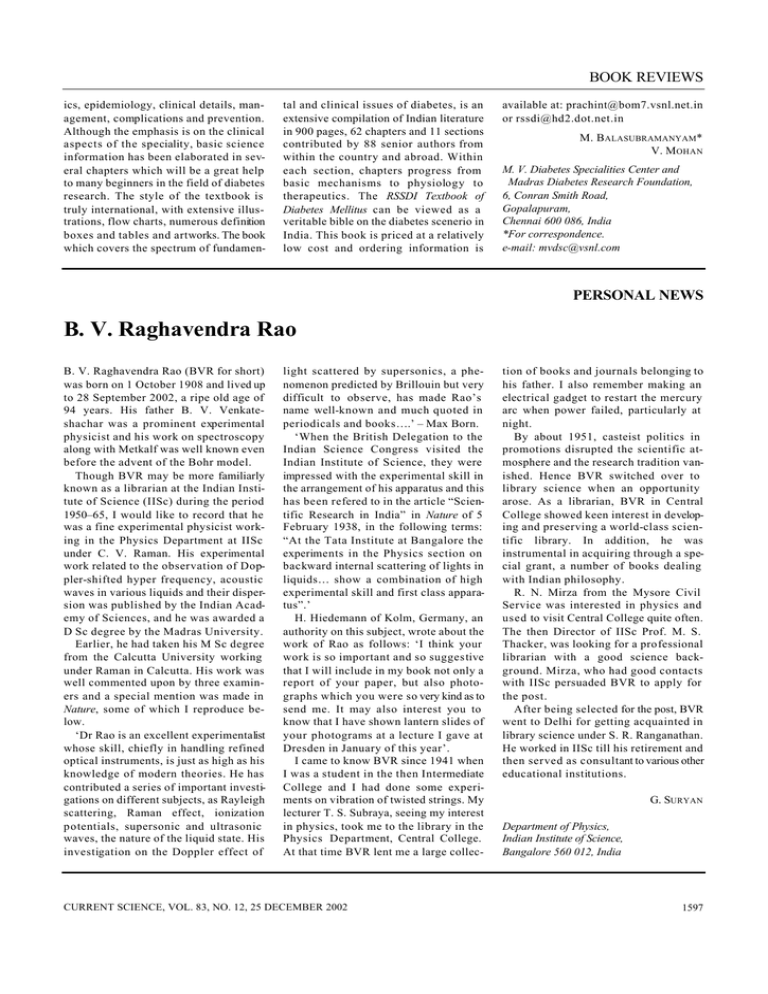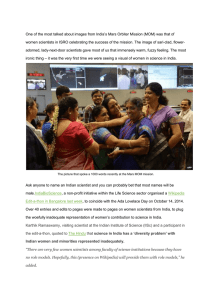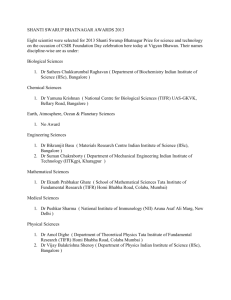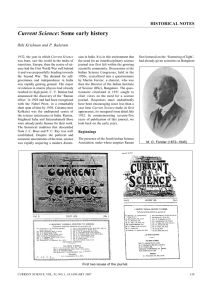BOOK REVIEWS
advertisement

BOOK REVIEWS ics, epidemiology, clinical details, management, complications and prevention. Although the emphasis is on the clinical aspects of the speciality, basic science information has been elaborated in several chapters which will be a great help to many beginners in the field of diabetes research. The style of the textbook is truly international, with extensive illustrations, flow charts, numerous definition boxes and tables and artworks. The book which covers the spectrum of fundamen- tal and clinical issues of diabetes, is an extensive compilation of Indian literature in 900 pages, 62 chapters and 11 sections contributed by 88 senior authors from within the country and abroad. Within each section, chapters progress from basic mechanisms to physiology to therapeutics. The RSSDI Textbook of Diabetes Mellitus can be viewed as a veritable bible on the diabetes scenerio in India. This book is priced at a relatively low cost and ordering information is available at: prachint@bom7.vsnl.net.in or rssdi@hd2.dot.net.in M. B ALASUBRAMANYAM* V. MOHAN M. V. Diabetes Specialities Center and Madras Diabetes Research Foundation, 6, Conran Smith Road, Gopalapuram, Chennai 600 086, India *For correspondence. e-mail: mvdsc@vsnl.com PERSONAL NEWS B. V. Raghavendra Rao B. V. Raghavendra Rao (BVR for short) was born on 1 October 1908 and lived up to 28 September 2002, a ripe old age of 94 years. His father B. V. Venkateshachar was a prominent experimental physicist and his work on spectroscopy along with Metkalf was well known even before the advent of the Bohr model. Though BVR may be more familiarly known as a librarian at the Indian Institute of Science (IISc) during the period 1950–65, I would like to record that he was a fine experimental physicist working in the Physics Department at IISc under C. V. Raman. His experimental work related to the observation of Doppler-shifted hyper frequency, acoustic waves in various liquids and their dispersion was published by the Indian Academy of Sciences, and he was awarded a D Sc degree by the Madras University. Earlier, he had taken his M Sc degree from the Calcutta University working under Raman in Calcutta. His work was well commented upon by three examiners and a special mention was made in Nature, some of which I reproduce below. ‘Dr Rao is an excellent experimentalist whose skill, chiefly in handling refined optical instruments, is just as high as his knowledge of modern theories. He has contributed a series of important investigations on different subjects, as Rayleigh scattering, Raman effect, ionization potentials, supersonic and ultrasonic waves, the nature of the liquid state. His investigation on the Doppler effect of light scattered by supersonics, a phenomenon predicted by Brillouin but very difficult to observe, has made Rao’s name well-known and much quoted in periodicals and books….’ – Max Born. ‘When the British Delegation to the Indian Science Congress visited the Indian Institute of Science, they were impressed with the experimental skill in the arrangement of his apparatus and this has been refered to in the article “Scientific Research in India” in Nature of 5 February 1938, in the following terms: “At the Tata Institute at Bangalore the experiments in the Physics section on backward internal scattering of lights in liquids… show a combination of high experimental skill and first class apparatus”.’ H. Hiedemann of Kolm, Germany, an authority on this subject, wrote about the work of Rao as follows: ‘I think your work is so important and so sugges tive that I will include in my book not only a report of your paper, but also photographs which you were so very kind as to send me. It may also interest you to know that I have shown lantern slides of your photograms at a lecture I gave at Dresden in January of this year’. I came to know BVR since 1941 when I was a student in the then Intermediate College and I had done some experiments on vibration of twisted strings. My lecturer T. S. Subraya, seeing my interest in physics, took me to the library in the Physics Department, Central College. At that time BVR lent me a large collec- CURRENT SCIENCE, VOL. 83, NO. 12, 25 DECEMBER 2002 tion of books and journals belonging to his father. I also remember making an electrical gadget to restart the mercury arc when power failed, particularly at night. By about 1951, casteist politics in promotions disrupted the scientific atmosphere and the research tradition vanished. Hence BVR switched over to library science when an opportunity arose. As a librarian, BVR in Central College showed keen interest in developing and preserving a world-class scientific library. In addition, he was instrumental in acquiring through a special grant, a number of books dealing with Indian philosophy. R. N. Mirza from the Mysore Civil Service was interested in physics and used to visit Central College quite often. The then Director of IISc Prof. M. S. Thacker, was looking for a professional librarian with a good science background. Mirza, who had good contacts with IISc persuaded BVR to apply for the post. After being selected for the post, BVR went to Delhi for getting acquainted in library science under S. R. Ranganathan. He worked in IISc till his retirement and then served as consultant to various other educational institutions. G. SURYAN Department of Physics, Indian Institute of Science, Bangalore 560 012, India 1597





